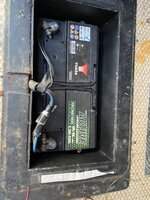- May 4, 2023
- 40
- 19
- Funster No
- 95,716
- MH
- Fiat Ducato Mooveo
Picked the van up from storage tonight for a 2 night off grid & a 2 night with EHU. Leisure battery is completely gone. Tried driving for 30mins but still nothing. If the battery is just flat will 30mins be enough should I drive a bit more?
Of course it may not be the battery it may be the connection. Is there anyway to find out? This is our battery.

Of course it may not be the battery it may be the connection. Is there anyway to find out? This is our battery.


